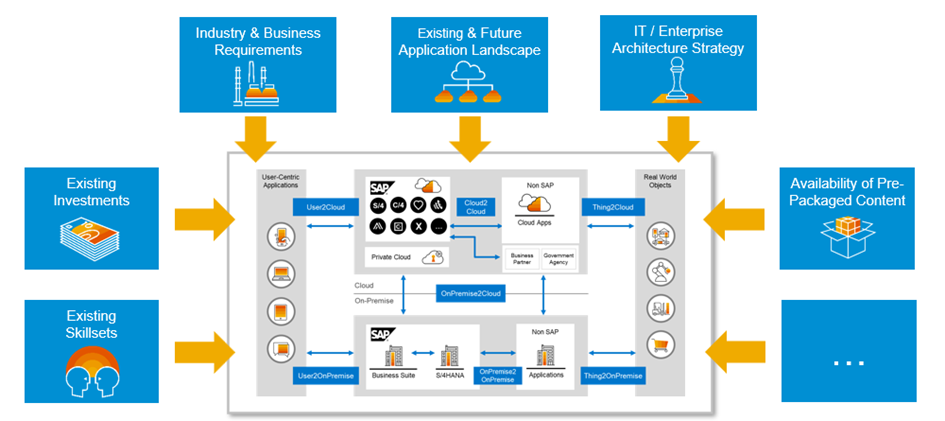Successful IT Projects with InnovateSAP and ISA-M: Holistic Integration
In an increasingly connected world, you as a company are faced with the challenge of keeping track of the hybrid system landscape and enabling efficient and problem-free integration of different systems . With our HO2 initiative InnovateSAP, based on the SAP Integration Solution Advisory Methodology (ISA-M), we offer you a tailor-made solution that addresses exactly these challenges.
Starting situation
Your organization is faced with the need to manage the interfaces between disparate systems and integration domains . This includes data, process, user and IoT integration. Our goal is to bring clarity and structure to your complex enterprise architecture and provide a systematic approach to integration.
Solution approach with ISA-M in conjunction with InnovateSAP
The ISA-M extended by HO2 as part of the InnovateSAP initiative supports the principle of holistic integration by providing a systematic methodology. This methodology helps you as an enterprise architect to define, evaluate, and evolve your integration architecture. By defining integration policies and incorporating both SAP and non-SAP integration technologies, we create a flexible framework tailored to your specific context. Your company doesn’t have real-time streaming data pipelines in place or is struggling to implement them? With the help of our initiative, such GAPs will be identified and corresponding technologies and services will be presented to close your gaps. In the course of this, we advise you on how to implement your goal in the best possible way and openly explain the strengths and weaknesses of the existing options. In terms of the problem, the Kafka platform provides an efficient approach to data stream processing. This service combines messaging, storage, and stream processing to enable analysis of both historical and real-time data. One advantage of Kafka and its use in so-called event-driven architectures is the decoupling of individual applications by a message system. Even though you have to take care of managing message partitioning and assigning sequential IDs (offset) yourself, this empowers you to incorporate your own logic into the process. This allows for any order and multiple readings. Through our efficient fit-gap analysis, we offer you an excellent opportunity to make strategic decisions.
Steps of implementation
HO2 provides clarity for your enterprise and integration architecture. We’ll help you design your integration strategy. Our approach, based on ISA-M, promotes innovation and thus enables the targeted introduction of new techniques and the improvement of your processes. Furthermore, after using this new method, you will be able to accelerate your proof of concept .
- Identification of technologies and services: We start with a thorough analysis of existing and potential technologies and services.
- Determination of integration domains and styles: We then define the integration domains (system connections) and integration styles (data-centric, user-centric, process-centric, and IoT-centric).
Your complete system landscape is now transparent to you. You will gain a clear insight and overview of the relationships between the systems and the basic structure behind them. In doing so, you have created a basis for clearly communicating the use of new technologies and the evaluation of existing concepts and making them sustainable. You can now effectively face complex challenges associated with enterprise architectures, which are often associated with high costs.
- Development of Use Case Patterns: By defining specific scenarios within the integration types, decision tables, criteria, and templates can be created for a structured and efficient implementation of future integrations.
- Customization of integration roles: ISA-M takes into account commonly used integration roles within organizations. These roles can serve as a foundation and can be individually adapted to the needs of your company, for example to establish an integration competence center.
After the last two implementation steps, you can further refine the existing structure and classify your use cases. This step brings you two decisive advantages:
- Your development team receives a concrete process model for each use case, so that projects are completed more accurately and quickly. Time-consuming, case-specific work is no longer necessary.
- The proof of concept is accelerated.
Results and Benefits
The result is a tailor-made, flexible and ready-to-use integration architecture, which is made possible by the InnovateSAP initiative using ISA-M. Our methodology not only supports the clear definition of integration policies, but also promotes the inclusion of diverse technologies and services to optimize system integration. With InnovateSAP and ISA-M as a foundation, your organization can build a robust integration ecosystem that enables it to respond quickly and efficiently to change, thus securing a sustainable competitive advantage.
At InnovateSAP , we strive to bring clarity to the complex world of IT and support you on your digital transformation journey.








